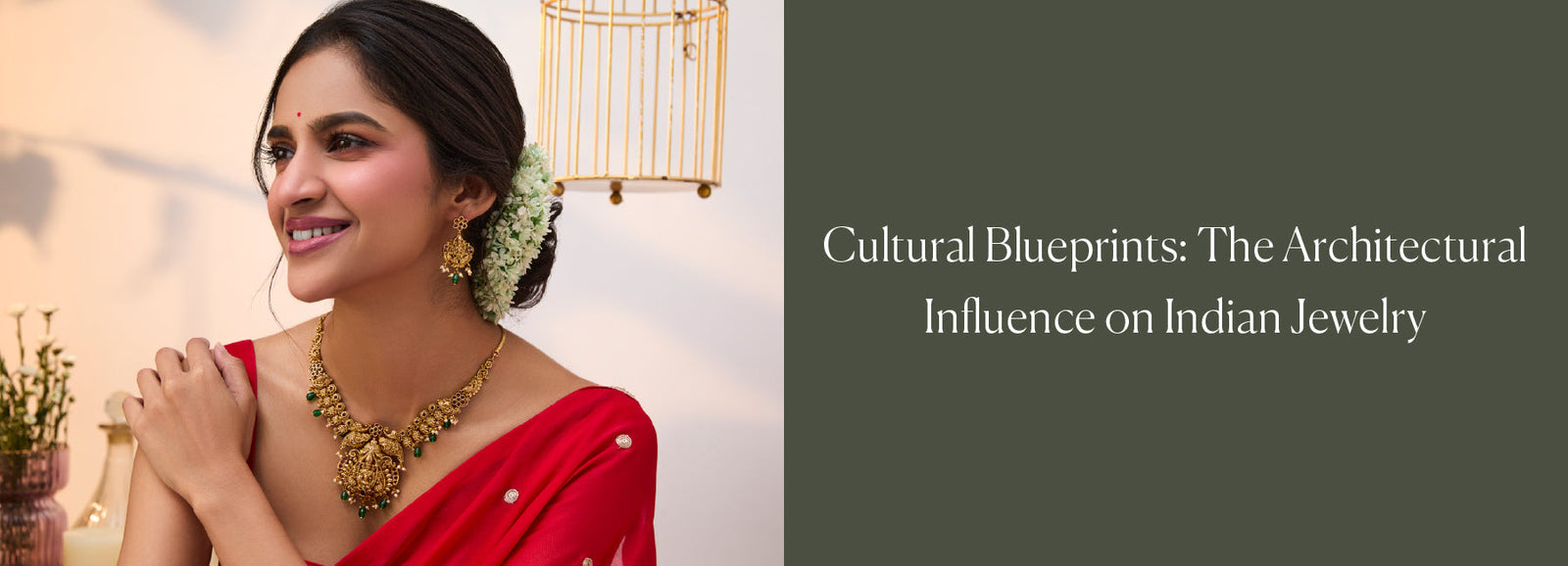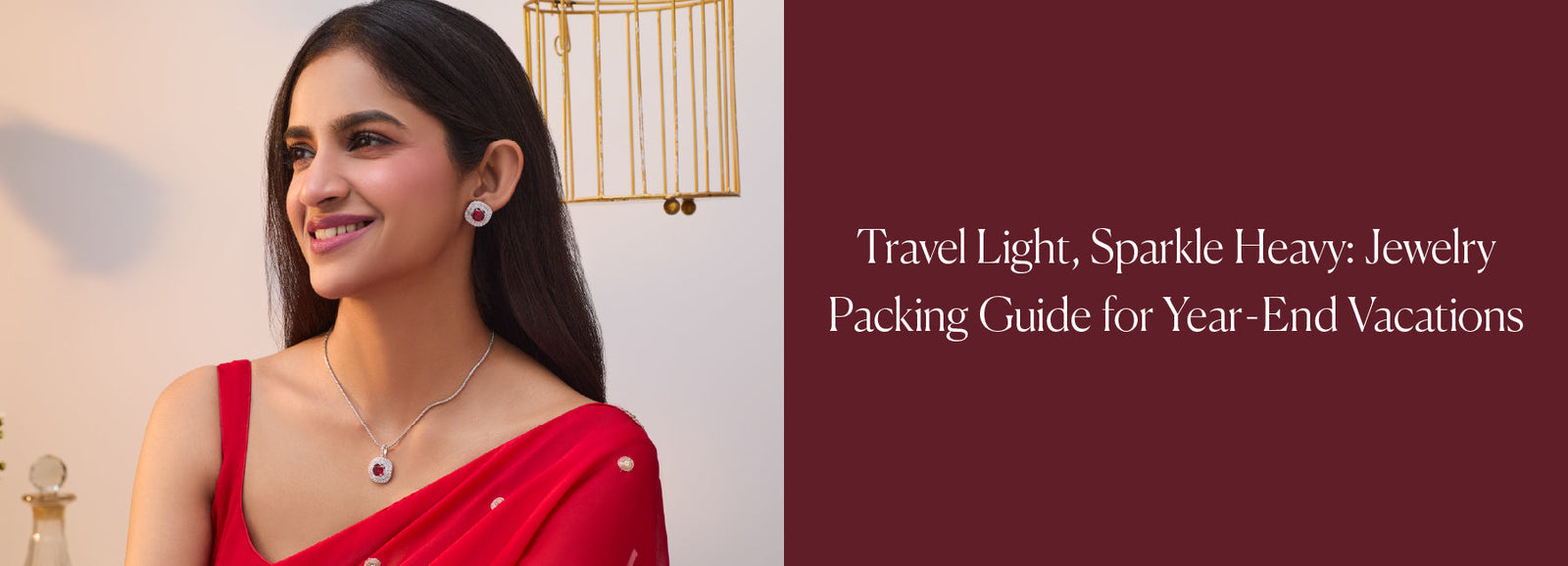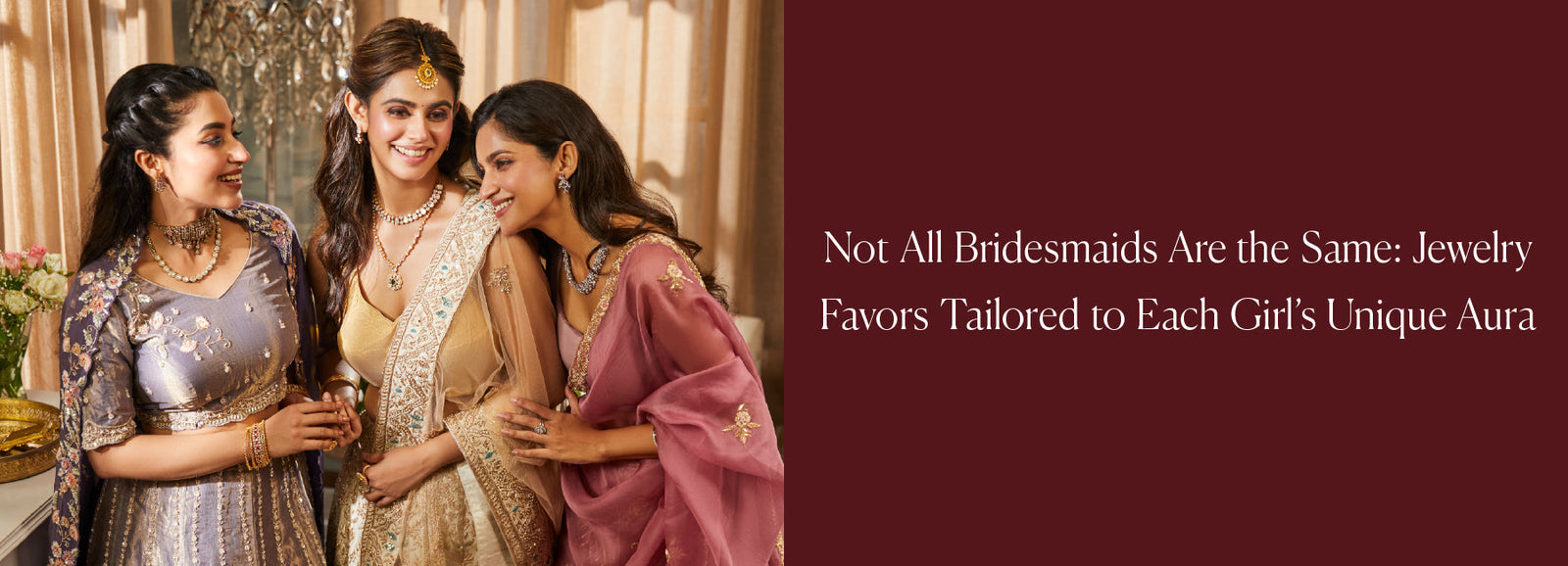Indian jewelry is a living narrative and carries centuries of history or cultural storytelling. Indian architecture is one of the most fascinating influences among its many inspirations. The country’s architectural marvels have been quietly shaping the way Indian jewelry is designed for centuries. You may find traditional jewelry inspired from towering temple gopurams to intricate palace jalis.
Let us dive into how Indian architecture which is our cultural blueprint has left its mark on everything from bridal Kundan necklace sets to ornate temple earrings. If you’ve ever admired the symmetry of a jali pattern in a bangle or the dome-like motif on a choker, you’ve been looking at a small piece of India’s monumental legacy.
THE MARRIAGE OF STONE AND METALWORK
Jewelry and architecture might seem like two different worlds. But they share the same artistic DNA in India. Both require meticulous craftsmanship, deep cultural symbolism, and a mastery of materials.
> Stone carving meets gemstone setting: The precision used to carve sandstone pillars is mirrored in the way artisans set delicate gemstones in gold.
> Symmetry and geometry: Indian forts and temples thrive on mathematical precision. This design philosophy is equally present in the symmetrical layouts of necklaces and earrings.
> Storytelling through motifs: Temple walls narrate mythological tales just as jewelry often carries miniature depictions of deities and nature.
This crossover didn’t happen by accident. It grew out of centuries of shared craftsmanship between architects and jewelers.
TEMPLE ARCHITECTURE AND THE RISE OF TEMPLE JEWELRY
One of the most direct architectural influences on Indian jewelry is seen in temple jewelry.
> Gopuram inspiration: The pyramid-like temple entrances (gopurams) inspired multi-layered necklace designs.
> Intricate carvings: The detailed engravings on temple pillars echo in the filigree work of gold bangles.
> Deity motifs: Sculptures of Lakshmi or Vishnu from temple sanctums are replicated in pendant necklaces and choker sets.
Temple jewelry has eventually moved from sacred spaces to bridal trousseaus. It symbolizes heritage and auspiciousness while remaining a timeless style statement.
MUGHAL ARCHITECTURE AND THE GRANDEUR OF KUNDAN JEWELRY
The Mughal era introduced opulence and an undeniable sense of grandeur to Indian design. The same aesthetic principles that gave us the Taj Mahal’s marble inlay work also shaped Kundan jewelry. The jewelry stye is known for its regal style and characterized by elaborate gemstone settings.
> Pietra dura influence: The floral inlay patterns in Mughal palaces inspired gemstone arrangements in Kundan necklaces.
> Arches and domes: The crescent-shaped arches of Mughal forts inspired chandbali earrings or pendant silhouettes.
> Luxury craftsmanship: The perfection in symmetry and polish found in Mughal halls is mirrored in the flawless surfaces of Kundan pieces.
You’re essentially carrying a portable piece of Mughal architecture when you wear a Kundan choker set, just scaled down to fit around your neck.
PALACE JALI WORK AND LATTICE MOTIFS IN JEWELRY
You’ve probably noticed the intricate geometric patterns if you’ve ever been to Rajasthan’s Hawa Mahal or seen the jali (lattice) work in Indian palaces. These same patterns have found a permanent home in jewelry design.
> Geometric precision: Lattice-style gold earrings mimic the cut-outs seen in palace windows.
> Airy elegance: Jali-inspired jewelry offers an open, lightweight elegance just as jali screens allow light and air to pass through.
> Versatile adaptation: These designs translate beautifully into both traditional and contemporary jewelry.
DOMES, SPIRES, AND ORNAMENTAL DETAILS
Domed shapes and pointed finials are recurring themes in Indian jewelry. You may notice such details in onion domes of Islamic architecture to the ornate spires of Hindu temples.
> Earrings as domes: Dome-shaped jhumka earrings resemble miniature temple domes.
> Choker pendants as spires: Vertical pendants mimic temple shikharas (spires).
> Layered detailing: Many bridal necklaces feature a tiered structure reminiscent of multi-level palace roofs.
This use of architectural silhouettes in jewelry is symbolic of spirituality and prosperity.
REGIONAL ARCHITECTURAL STYLES IN JEWELRY
Indian architecture varies across regions and so does its influence on jewelry.
> South India: Heavy gold pieces with temple and deity motifs reflect the Dravidian temple style.
> Rajasthan & Gujarat: Mirror work and jali-inspired designs echo the ornate palace interiors of the region.
> Kashmir: Delicate filigree patterns reflect the intricacy of wooden latticework in Kashmiri homes.
> Bengal: Floral gold designs are reminiscent of terracotta temple carvings.
Every region offers a unique architectural influence that enriches its jewelry traditions.
MODERN JEWELRY WITH ARCHITECTURAL ROOTS
Modern jewelry designers are blending age-old architectural influences with contemporary styles to appeal to global buyers.
> Minimalist temple motifs: Smaller and sleeker versions of traditional temple jewelry for everyday wear.
> Geometric gold bangles: Inspired by palace jali work but designed for modern stacking trends.
> 3D-printed designs: Digital craftsmanship allows jewelery designers to experiment with patterns once only possible in large-scale stone carvings.
These fusions keep heritage alive while making it wearable in daily life.
WHY ARCHITECTURAL JEWELRY RESONATES GLOBALLY
The appeal for the global jewelry lovers lies in the combination of exotic heritage and wearable art. Architectural jewelry feels luxurious yet deeply meaningful. It is perfect for brides and anyone who appreciates artistry.
> Cultural storytelling: Every design carries a piece of India’s monumental history.
> Timeless aesthetics: The same motifs that have survived centuries in stonework also transcend fleeting fashion trends.
> Versatility: Works with both traditional Indian attire and contemporary global fashion.
STYLING TIPS FOR ARCHITECTURAL-INSPIRED JEWELRY
1. With traditional wear: Pair a temple choker setwith a Kanjeevaram saree for a heritage-rich bridal look.
2. With Indo-western outfits: Style jali-inspired earrings with a solid maxi dress for a fusion vibe.
3. For wedding events: A Mughal-inspired Kundan necklace set elevates even a simple lehenga or gown.
4. For casual chic: Try dome-shaped jhumka earrings with a crisp white Kurta and jeans.
FINAL THOUGHTS
Indian jewelry is architecture you can wear. Architectural-inspired jewelry has designs that are timeless and can be passed down through generations as heirlooms. Moreover, owning such a piece feels like carrying a fragment of India’s cultural blueprint wherever you go.
Discover Your Heritage, One Design at a Time
Explore our collection of architectural-inspired Indian jewelry at Tarinikaand find pieces that are as monumental as the inspirations behind them. You may be looking for divine temple jewelry or regal bridal jewellery styles for your wedding.Our designs carry the soul of India’s greatest monuments and are ready to become part of your story.








